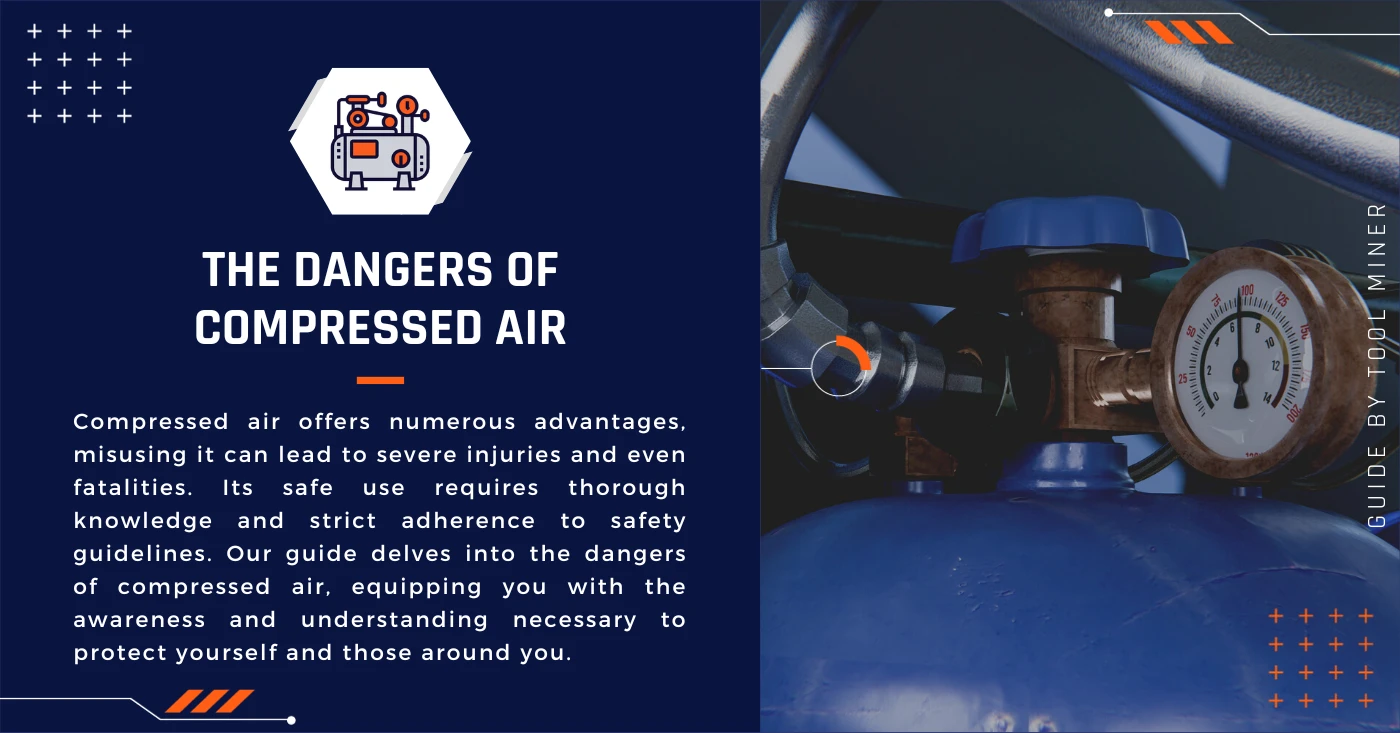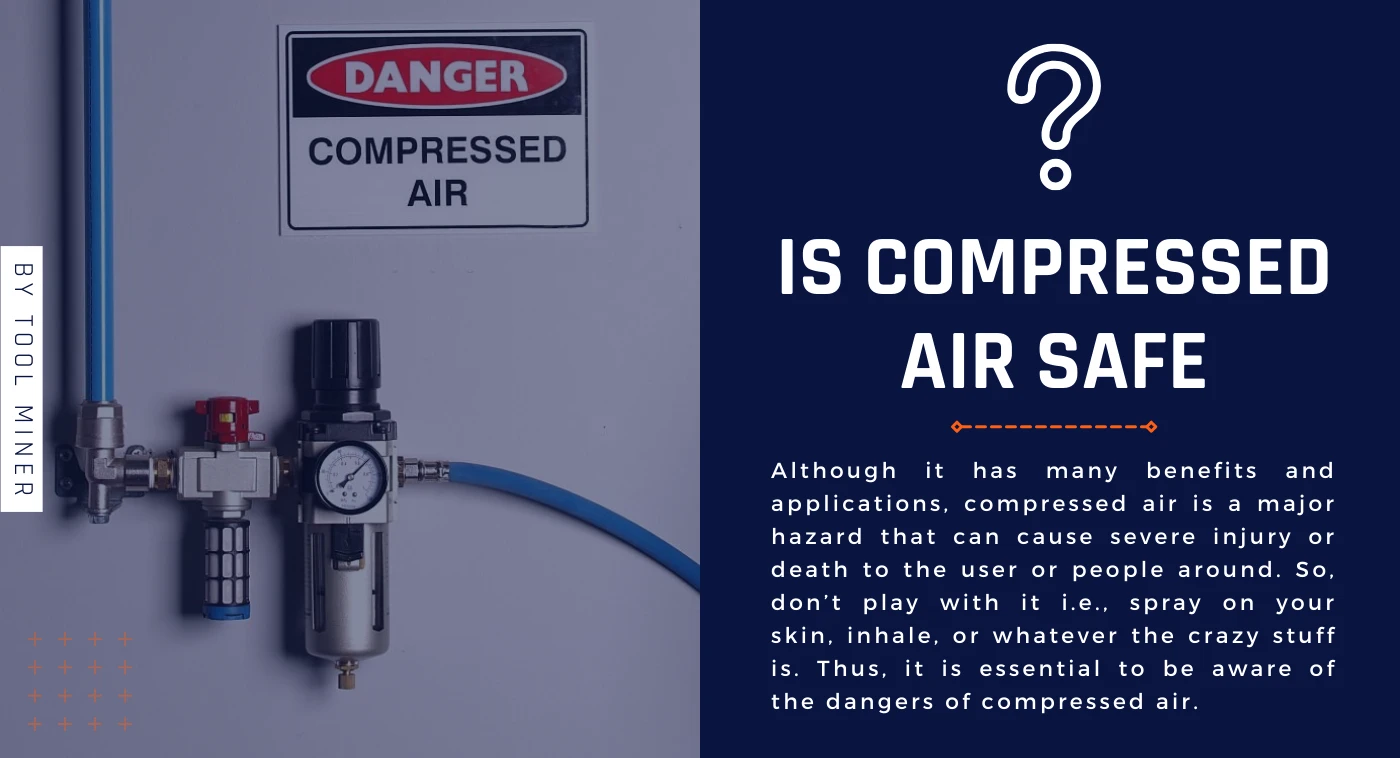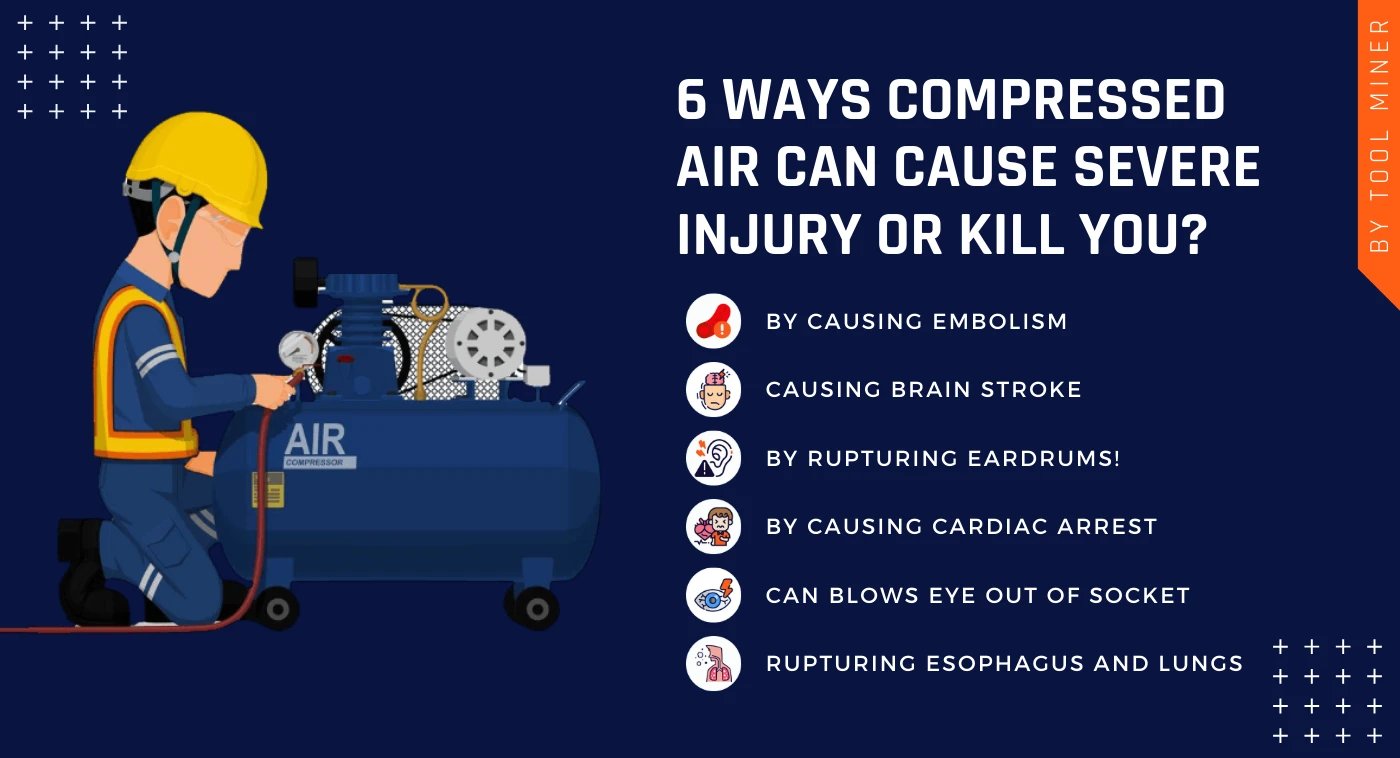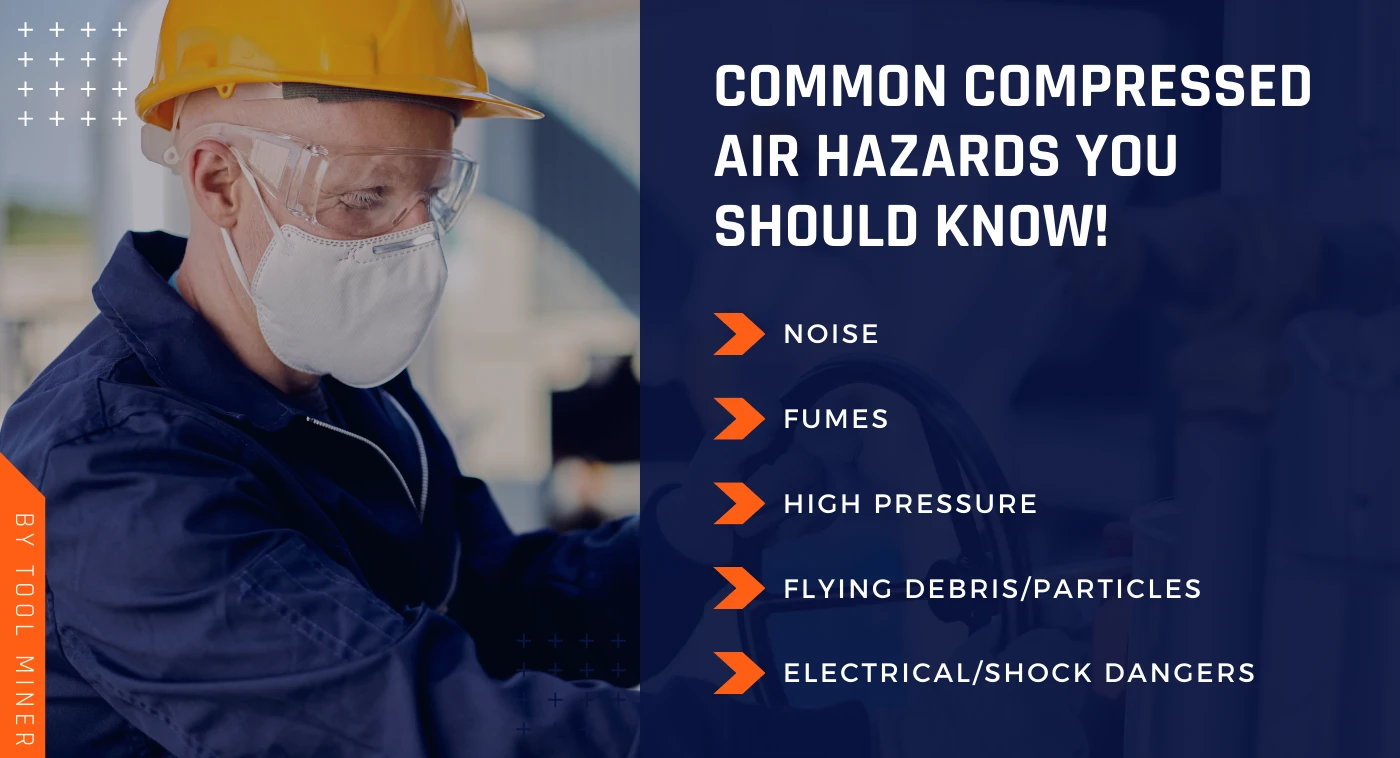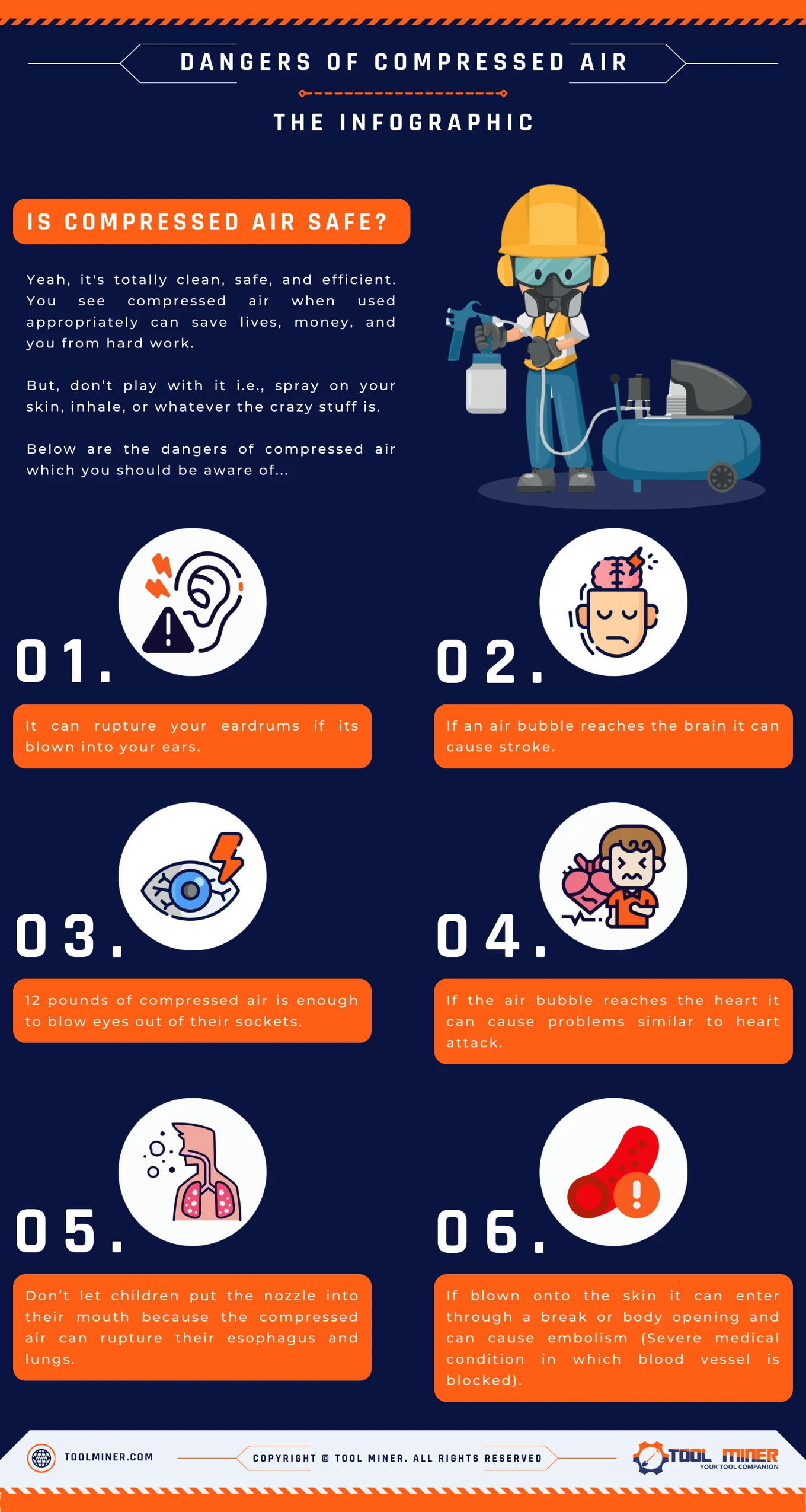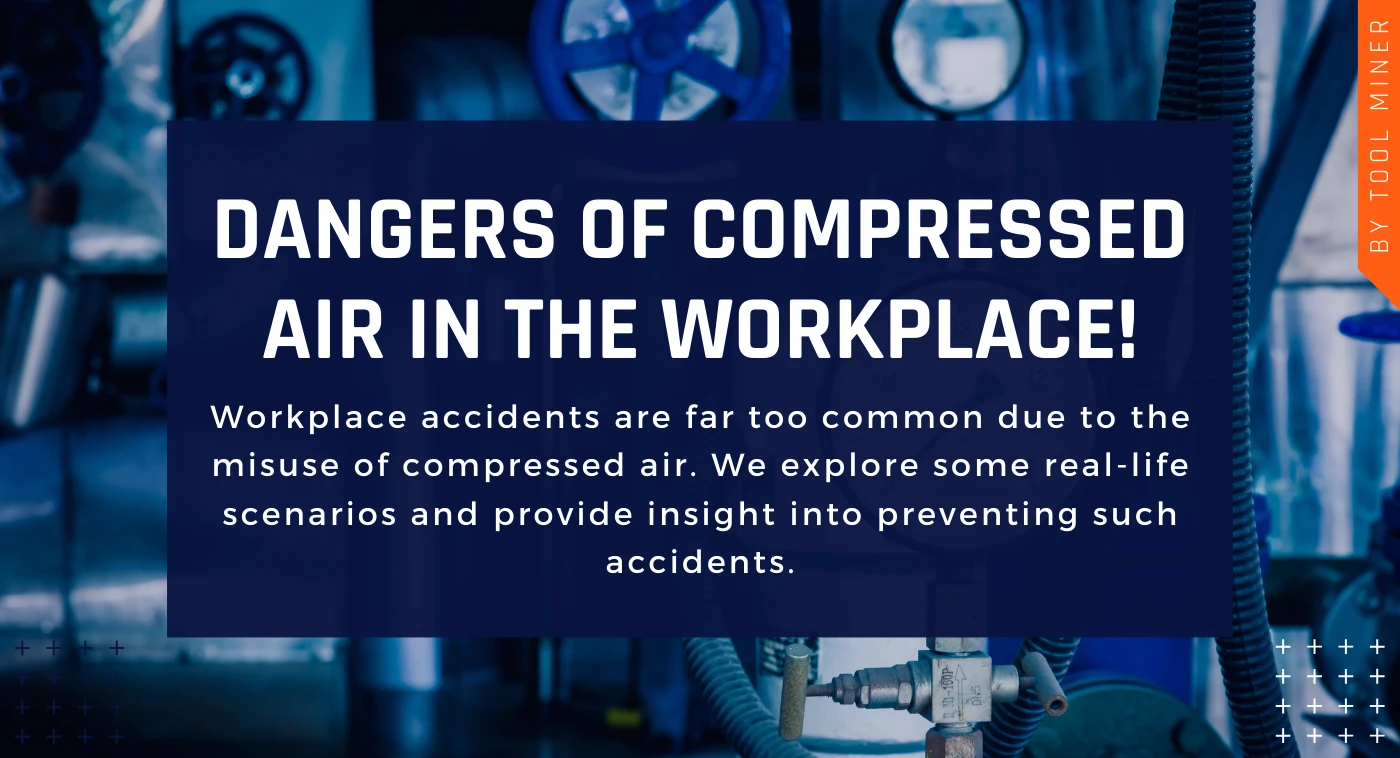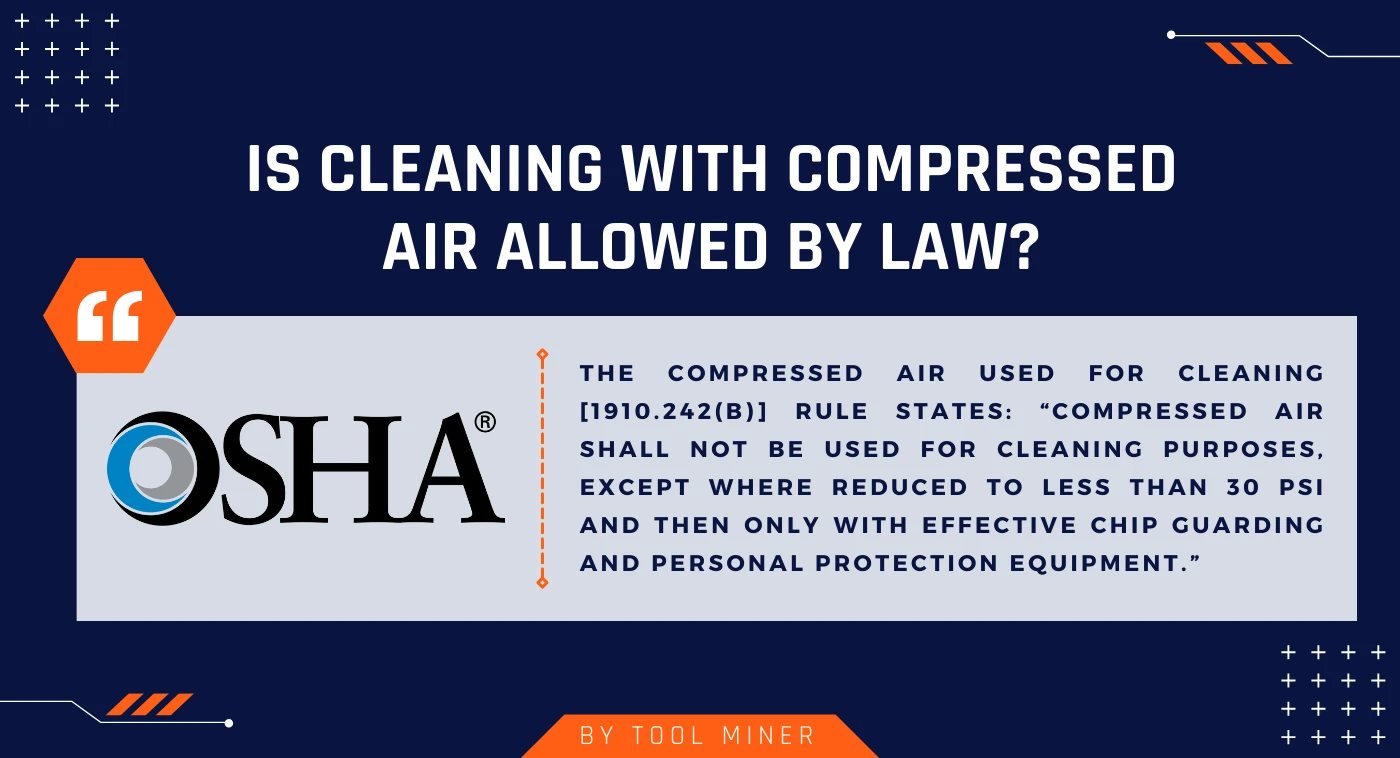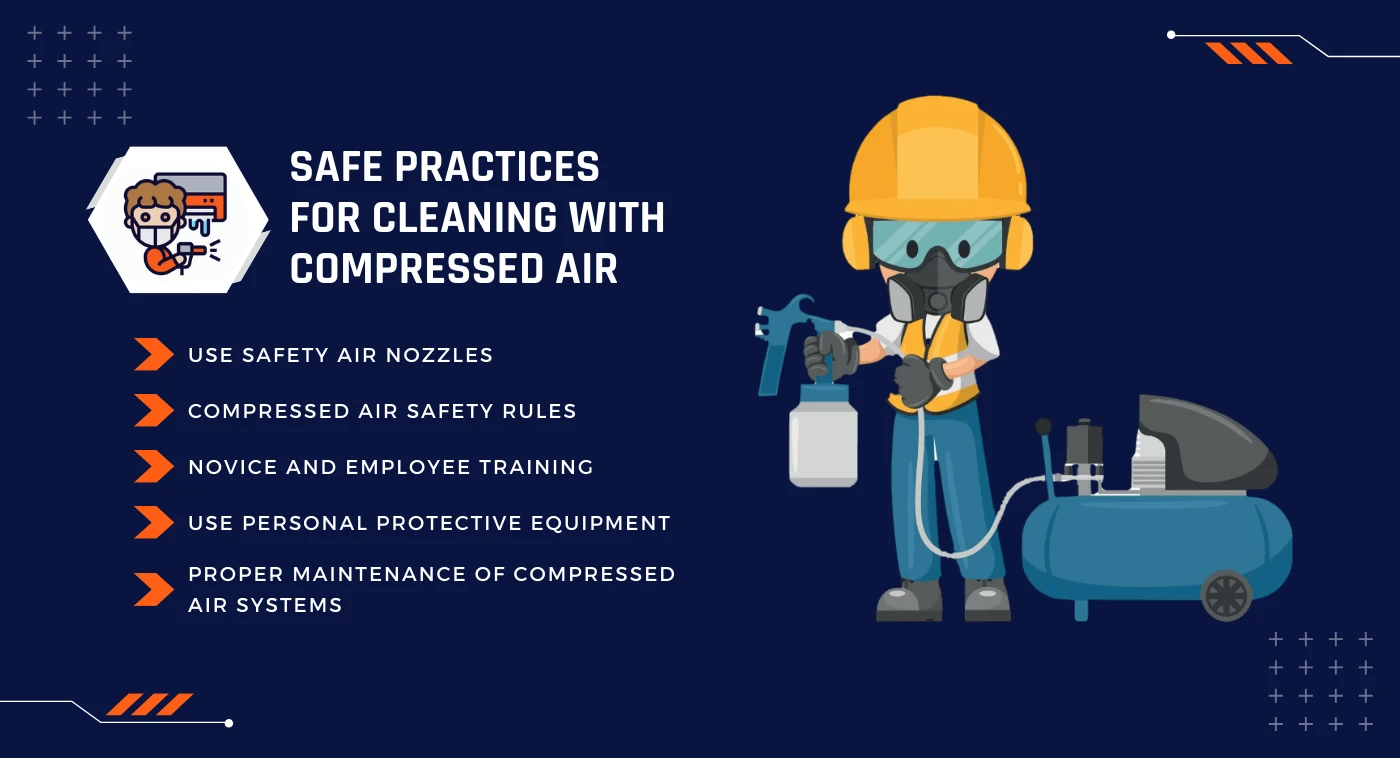What Are the Dangers of Compressed Air? [2024 Guide]
In a world powered by machinery and technology, compressed air serves as a versatile and essential tool, finding its application in various industries and everyday tasks.
But it can be a double-edged sword. While it offers numerous advantages, misusing it can lead to severe injuries and even fatalities. Its safe use requires thorough knowledge and strict adherence to safety guidelines.
Our guide delves into the dangers of compressed air, equipping you with the awareness and understanding necessary to protect yourself and those around you.
Is Compressed Air Safe?
As you know, compressed air is a concentrated stream of air with high speed and pressure compared to normal air.
Although it has many benefits and applications, compressed air is a major hazard that can cause severe injury or death to the user or people around him.
So, don’t play with it i.e., spray on your skin, inhale, or whatever the crazy stuff is. Thus, it is essential to be aware of the dangers of compressed air.
Compressed Air Awareness, is It Essential?
With great power comes great responsibility, and understanding the potential dangers is crucial for safe utilization.
Before we explore the hazards in detail, let’s underline why awareness of compressed air dangers is crucial.
With the widespread use of compressed air in both professional and DIY settings, safety should be paramount.
The dangers associated with compressed air are often underestimated, leading to avoidable accidents.
How Can Compressed Air Kill You?
Below I am gonna shortlist some of the main reasons compressed air can cause severe injury or kill you.
- It can rupture eardrums if blown into the ears.
- If inhaled it can rupture the esophagus and lungs.
- If an air bubble reaches the brain it can cause stroke.
- If the air bubble reaches the heart it can cause sudden cardiac arrest.
- 12 pounds of compressed air is enough to blow eyes out of their sockets.
- If blown onto the skin it can enter through a break or body opening and can cause embolism (A severe medical condition in which blood vessel is blocked by an air bubble).
Compressed Air Hazards and Risks
Compressed air, when misused, poses significant health risks. Here I am gonna discuss in detail various health-related dangers associated with compressed air.
Infographic | What Are The Dangers of Compressed Air?
Hey buddies! Below I have designed a small infographic that you can quickly skim to know the dangers of compressed air.
Dangers of Compressed Air on Skin!
Compressed air can cause severe damage to the skin due to its high pressure. It happens especially in the case of large industrial air compressors which can exert highly pressurized air.
The pressurized air stream can dislodge small particles, turning them into high-velocity projectiles. Such projectiles include small particles, nuts, bolts, and other bits.
These projectiles can puncture the skin, leading to abrasions, cuts, and potential risk for infections which can later caused by other diseases.
The compressed air can enter through the cuts or wounds and make its way to blood vessels to cause embolism. In fact, there is one case well-documented in the OSHA Archive.
An employee developed an embolism on hand from compressed air. I have added that case study in the below Real-Life Case Study Section.
Can Compressed Air Damage Eyes?
The eyes are particularly vulnerable to compressed air. The fact is that 12 pounds of compressed air can blow your eye out of the socket.
This happens mostly at workplaces when the operator uses compressed air to blow off debris or clean it. I have a case study about 6 Cases of Severe Eye Injury below in the Case Studies Section.
The High-pressure air forces the debris, small particles, and small chips to bounce back into the eyes. Thus, resulting in eye injury or even permanent vision disability.
Ear Injuries!
The next most common injury after that happens a lot is an ear injury. Compressed accidentally blown into the ear can rupture your ear drum.
In severe cases, the damage results in permanent deafness. While in other cases, you face temporary hearing problems.
Often the damage is not recognized earlier, the symptoms develop slowly. So, it becomes difficult to determine when and how the hearing problem developed.
Even the noise from compressed air exhaust is irritating when used for blow-off or cooling. Not only does it affect the operator but the surrounding people also get affected by it.
You should know that a typical compressor sound level ranges from 40 to 90 dB. Long-time exposure to ranges above 85 dB can become lethal for your ears.
When working with a compressed air system or a compressor. Either you should reduce your compressor noise by following expert advice or you should buy a quiet air compressor.
Can compressed air get into your bloodstream?
Yes, it’s one of the most severe health risks. If air enters the bloodstream it can lead to embolism. An embolism is a condition where air or gas bubbles enter your bloodstream blocking the blood vessel.
Compressed Air Embolism
Compressed air embolism of an artery can cause conditions similar to paralysis, coma, heart attack, stroke, and even death depending upon the bubble size, location, and duration.
The Air Embolism is specifically related to scuba diving. It happens due to the wrong scuba diving setup as the compressed air is used in the form of oxygen underwater.
Can compressed air give you a heart attack?
Compressed air can also lead to cardiovascular issues, including heart attacks.
The bubble I mentioned earlier if gets into the blood vessel and blocks blood flow can cause sudden cardiac arrest.
Can Compressed Air Embolism Cause Brain Stroke?
To be honest not much has been specifically mentioned if working with compressed air has caused brain stroke.
The thing is Air Embolism caused by other factors including improper injection procedures, and scuba-diving as mentioned above.
I have mentioned another case of Cerebral Air Embolism in the below Real-Life Case Study Section. I suggest you should check that out as well.
Is Breathing Compressed Air Bad for You?
Inhaling compressed air can have serious consequences. No sane person would put a nozzle in their mouth to expose themselves to esophagus, lungs, stomach, and intestine rupture.
This can result in painful injuries, leading to surgeries, medications, prohibitions on your diet, and other long-term health issues.
Another case scenario is if you breathe into compressed air directly after compression. The compressed air contains (CO) Carbon Monoxide that comes compressor or compressor’s air intake.
If this hidden killer gets inside your body, then it’ll compete with the oxygen inside hemoglobin cells. Thus, it can cause various symptoms i.e., consciousness loss, and disorientation.
A higher concentration of CO can kill you within 60 minutes. This danger mostly lurks around scuba divers and firefighters. So, if you’re one of these then do read guidelines.
Also, avoid blowing compressed air on your navel. Because of the intensity of compressed air it can pass through clothing and enter through the navel into your intestines causing it to inflate or rupture.
Blood Poisoning Myth | Is Compressed Air Poisonous?
Blood Poisoning is by far the rare case when it comes to the dangers of compressed air. I haven’t seen in my life someone getting Blood poisoning. But, the danger does lurk.
What can happen is that fluids removed from a compressor system can evaporate into mist and can enter the mouth, inhaled, or can affect eyes causing a health hazard.
Another case would be with spray painting, and metal chips/dirt that are lethal to humans. By blowing off they can enter through an open cavity or a wound to cause blood poisoning.
Dangers of Compressed Air in the Workplace!
Workplace accidents are far too common due to the misuse of compressed air. We explore some real-life scenarios and provide insight into preventing such accidents.
Horseplay in Workplace!
I think the problem here is most people or beginners don’t know the hazards of compressed air. Many folks usually joke around with these kinds of things for fun.
I don’t take risks with our air compressor. We use working gloves and wear work clothes when using compressed air. Horseplay is one of the leading problems with compressed air injuries.
Dangers of Cleaning with Compressed Air?
The most common mistake made by people at workplaces is the use of compressed air for cleaning themselves. Many folks use it for cleaning machinery, other objects, surfaces, clothing, and other things.
Compressed air is not your everyday air that is used for blow-off or cleaning the debris out. The pressure can cause an embolism or lodge a metal chip, hazardous dust on your skin causing abrasion or wound.
Can Compressed cause explosion or fire?
The compressed air cannot react itself. So, it doesn’t happen unless other factors are at play here. The air compressor tank can explode if it builds too much pressure.
There is a risk of fire or explosion if you’re working with a combustible material, debris, or dust. These airborne particles can be ignited by the surrounding machinery causing fatal injury or death.
Another way it can cause explosion or fire is by expired compressed air cans. These cans are also known as air dusters used for dust and lint cleaning on electronics.
Be sure to check the expiration date of the can as it can cause severe injury or even death. Here, I have the Backyard Scientist explaining how a computer duster can explode.
Compressed Air Environmental Impact
Beyond personal safety, it’s crucial to consider the environmental impact of compressed air systems. Here I am gonna give you brief points that can be focused on to reduce compressed air environmental impact.
- Using oil-free air compressors
- Cleaning up the compressed air condensate
- Auditing the power consumption and electrical usage
- Replacing old and outdated compressed air equipment
- Timely repair of faulty compressors or compressed air systems
- Creating an Eco-friendly Environmental Plan for your company
Is Cleaning With Compressed Air Allowed By Law?
Understanding the legal aspects and regulations related to compressed air is essential for individuals and businesses.
What is the OSHA rule for compressed air limits?
To ensure workplace safety, numerous regulations and standards are in place, including those by the Occupational Safety and Health Administration (OSHA) in the United States.
The Oregon OSHA Rule states
The Compressed air used for cleaning [1910.242(b)] rule states:
“Compressed air shall not be used for cleaning purposes, except where reduced to less than 30 psi and then only with effective chip guarding and personal protection equipment.”
Occupational Safety and Health Administration (OSHA)
It’s well written in OSHA’s Fact Sheet.
Country Specific Regulations
Regulations and air pressure limits can vary from one country to another. We take a closer look at country-specific guidelines and legal requirements.
Canada Compressed Air Safety Regulations
In some countries, such as Canada, there are many regions where it is not allowed by law to use compressed air for cleaning.
Prince Edward Island, Labrador, Alberta, Newfoundland, Saskatchewan, and Quebec have specifically highlighted this problem:
- They said that compressed air should never be used for cleaning clothes in workplaces.
- Nor it should be used by a person to clean himself or direct it towards others.
- Using compressed air for cleaning machinery, work benches, tools, floors, surfaces, and structures should also be prohibited.
In Prince Edward Island, it’s not even allowed by law to disconnect even the airlines from pneumatic tools.
In other provinces, Federal regulations have limited the use of compressed air for cleaning purposes. These include Ontario, Nunavut, North West Territories, New Brunswick, Nova Scotia, British Columbia, and Yukon.
But, with these limited uses, they have also added that additional safety measures are required. Such as the person should be wearing personal protective equipment (PPE), and the machine should be specifically designed only for cleaning purposes.
Another thing the jurisdiction applies to special hazardous materials. Cleaning with compressed air shouldn’t be allowed when working with dangerous materials.
I have built a small table for this purpose below so you can easily understand.
| No | Provinces With Prohibitions | Hazardous Materials |
|---|---|---|
| 01 | British Columbia, Manitoba, New Brunswick, North West Territories, Nunavut, Ontario | Asbestos |
| 02 | British Columbia | Respirable Crystalline Silica and Rock Dust |
| 04 | Manitoba | Mould Contamination |
| 03 | British Columbia | Debris Containing Lead |
| 05 | Ontario | Combustible Dust |
UK Compressed Air Safety Regulations
In the UK, there is no specific law that bans the usage of compressed air for cleaning purposes. The Health and Safety Executive (HSE) book does warn against this activity.
“Very serious injuries, sometimes fatal, have occurred when the nozzle of the gun has been pointed toward the body, even at some distance from it. Many injuries occur when clothing is dusted down and because of this compressed air should never be used for cleaning clothing. Others are the result of horseplay.”
Health and Safety Executive HSG39
You should always consider checking the legislation where you live to avoid accidents, injuries, and deadly situations.
Safe Practices For Cleaning With Compressed Air
Practicing safe handling of compressed air and implementing safety measures is the key to avoiding accidents and injuries.
Using Personal Protective Equipment
Properly using and maintaining personal protective equipment (PPE) is essential for safeguarding workers. Especially, the sensitive parts from particles and dust under pressure.
In case of inhalable hazardous material, dustproof face masks for workers should be administered by the company. Below is a list of PPE that you should use when working with compressed air.
- Safety headwear
- Safety goggles
- Safety gloves
- Worker safe masks
- Hearing protection
- Long-sleeved shirts and pants
Proper Maintenance of Compressed Air Systems
Regular maintenance of compressors or heavy-duty compressed air systems ensures they operate safely and effectively, reducing the chances of malfunction.
Verify and check the hoses, joints, and valves if they are leaking or damaged. Always remember to use genuine compressor parts from the manufacturer.
If you use compressors such as tire inflators for inflation, then keep a note on pressure gauges. Regularly check, maintain, and replace them.
Use Safety Air Nozzles
Using a special Nozzle described by the OSHA Standard. They are also known as Safety Air Nozzles“ and they can reduce pressure up to 10 psi or even less. Another advantage they have is low noise emissions.
The Canada Compressed Air Safety has also legislated the following air pressure limits.
Air Pressure Limits Table
| No | Province | Air Pressure Limit |
|---|---|---|
| 01 | British Columbia | 70 kPa/10 psig |
| 02 | New Brunswick | 69 kPa |
| 03 | North West Territories | 68.9 kPa/10 psi |
| 04 | Nunavut | 68.9 kPa/10 psi |
| 05 | Yukon | 69 kPa/10 psi |
| 06 | Quebec | Less Than 200 kPa |
| 07 | By Federal Regulations | 69 kPa/10 psi |
Novice and Employee Training
Workplace safety can be significantly improved through employee training and strict compliance with safety guidelines.
The company should hold training and education sessions to properly train and educate the staff. So, they can avoid accidents, injuries, and harsh situations like these.
Compressed Air Safety Rules
- Identifying and avoiding unsafe practices with compressed air is critical to prevent accidents.
- Don’t point the air hose nozzle at your body part or at other workers.
- Don’t ever try to kink the air hose just to stop the air. Properly turn it off from the control valve.
- After you complete your work turn off the compressor and the attached pneumatic tool or accessory.
- Avoid having Horseplay in workplaces.
In some cases, it’s safer to use alternatives to compressed air for specific tasks including cleaning.
Real-Life Case Studies and Examples
Real-world incidents and successful safety implementations provide valuable insights.
Real-Life Case Study 1: Employee Develops Embolism On Hand From Compressed Air
In my first case study, I am gonna highlight the incident about an employee getting an embolism due to compressed air. The accident summary is below:
At 8:30 a.m. on May 20, 2019, an employee was using a compressed air gun to clear a paper jam from a Gambini Rewinder Machine. The employee lost his grip on the air gun and cut his hand. The laceration to the employee’s hand caused an embolism to form requiring hospitalization.
Occupational Safety and Health Administration (OSHA)
My opinion is that the air bubbles can enter through existing wounds even if it’s from compressed air or by other means.
Real-Life Case Study 2: Compressed Air Injury of the Eyeball
According to Taylor and Francis, listed in the Archives of Environmental Health, there was a report of 6 Cases of Severe Eye Injury due to compressed air.
Farouk A. Hosni FRCSE, MCh, PhD (1973) Compressed Air Injury of the Eyeball, Archives of Environmental Health: An International Journal, 27:1, 11, DOI: 10.1080/00039896.1973.10666299
Archives of Environmental Health
Real-Life Case Study 3: Unusual Case of Ischemic Stroke – Cerebral Air Embolism
One article according to PMC Pub Med Central states an unusual case of Cerebral air embolism.
A 71-year-old hypertensive and diabetic male had been diagnosed with carcinoma bladder and underwent radical cystectomy with ileal conduit construction. Subsequently, he made a good recovery and was shifted to the ward on the 5th post-op day in stable condition.
On the 7th post-op day the patient was mobilized on a chair and intravenous antibiotics were injected through the central venous catheter by the nursing staff in a sitting position. Immediately following the injection, the patient developed abrupt onset tachypnea, profuse sweating followed by unresponsiveness.
An urgent NCCT head revealed a massive air embolism in the right hemispherical vessels. It’s courtesy of PMC that they reported this incident and I am also adding Images to the Report of that Patient.
PMC Pub Med Central states
Nevertheless, air bubbles can get into the brain to cause brain stroke. But, I haven’t seen specifically if compressed air has been the cause.
Conclusion
Summarizing the key points and emphasizing the importance of safety and responsibility. Compressed air, a powerful ally, can also be a formidable adversary when mishandled.
Skin injuries, eye problems, respiratory risks, and heart and brain issues. These are all of the concerns you should keep in mind.
Understanding and respecting the potential dangers of compressed air, we can harness its utility without compromising safety.
Following strictly the safety guidelines, and avoiding horseplay to keep yourself and your surroundings safe. Remember, knowledge is the key to safe compressed air practices.
Dangers of Compressed Air FAQs
How harmful is compressed air?
Compressed air can cause severe harm, including skin injuries, internal issues, and even death when used improperly for cleaning.
Is compressed air safe for humans?
Compressed air can be safe if used following proper safety guidelines, but it can be dangerous if misused.
Is compressed air banned?
The use of compressed air for cleaning is prohibited in many jurisdictions and regulated by safety standards.
What are three things you should never do with compressed air?
Never point compressed air nozzles at your body, use high-pressure air on your skin, or clean your clothing with compressed air.
Is compressed air bad for your lungs?
Inhaling compressed air can be harmful to the lungs, potentially causing respiratory issues.
What is the safe compressed air pressure for cleaning?
The safe pressure for cleaning with compressed air typically falls below 30 psi, following OSHA guidelines.
What PPE is required for compressed air?
Here is a list of PPE that you should use when working with compressed air:
1. Safety headwear
2. Safety goggles
3. Safety gloves
4. Worker safe masks
5. Hearing protection
6. Long-sleeved shirts and pants
What is the most common contamination in compressed air systems?
The most common contaminants in compressed air systems include particles, oil, and water.
Are compressed air dusters safe?
Compressed air dusters can be safe if used correctly following safety guidelines. Don’t shake them when using, and avoid tilting too much as the nozzle will spray the liquid.

